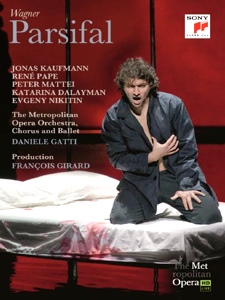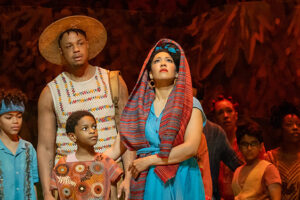
One of the things that made François Girard’s 2013 production of Parsifal at the Met so compelling was the way he tried to make the tale of suffering and temptation relevant to a contemporary audience. The French-Canadian director set the looming devastation of Montsalvat in a bleak, desiccated landscape populated by characters in modern dress who emerged from behind a mirrored curtain that reflected the auditorium. Stylized gestures and dramatic lighting evoked an abstract reality that heightened one’s awareness of the way nature and society work.
What was a gripping live theatrical experience doesn’t come off quite the same on DVD. The mysterious and timeless qualities, reinforced by conductor Daniele Gatti’s spacious tempi, are undercut by busy, at times ill-considered camera work. Continuous cuts between long shots, close ups and tracking views from the stage apron bring an unsettled feel to slow-moving, ethereal scenes, particularly in the final act. The tight focus on the principals instead of Girard’s careful groupings of characters makes the proceedings feel more like an event than art.
Fortunately, the captivating trio of René Pape, Jonas Kaufmann and Peter Mattei help convey Girard’s conception of a Buddhism-inspired spiritual voyage to enlightenment and turn in performances that surely rank among the most memorable produced during the Wagner bicentennial year.
As Gurnemanz, Pape does wonders with the opera’s long lines and harmonic shifts, making the third act’s description of nature renewing itself unfold like a bel canto aria. Roughly the age of his character in Act 1, the Dresden-born bass has a talent for layering text in sound, coloring his vowels and meshing beautifully with Gatti and the Met Orchestra’s rich yet transparent accompaniment. The way he admonishes Parsifal for killing an innocent swan in the opening act is exquisite and heartbreaking.
Kaufmann’s tenor sounds fuller on DVD than it did live in the big house, and the baritonal shadings and distinctive timbre add a degree of expressivity to his already impressive interpretation. What’s especially noteworthy is the finely etched transformation from a callow, indifferent youth to a not-quite-mature redeemer. Small gestures like an uncomprehending glance or indifferent shrug that weren’t very obvious in the auditorium are highly effective on video. His grim yet serene mien in the final act punch home Girard’s notion that spiritual healing won’t conclude at the final curtain.
Mattei’s take on Amfortas seemed a bit hammy from my vantage point in the theater. On DVD, it is nuanced and almost painful to watch. Oozing blood and leaning for support on the shoulders of two knights, he makes the first act narrative an anguished and deeply personal appeal for a life free of religious rites or tenets. Though his body is wracked with tremors and loaded with physical tension, the Swedish baritone’s lyricism and firm line never waver, as if he were singing Wolfram instead of the tormented Grail king.
The lone female principal, Katarina Dalayman, turns in a fine dramatic performance but sounds stretched by Kundry’s treacherous intervals and high B’s in Act 2. Her diction is not a model of precision, either. She does ably invoke the terror of the line “Lachte” in the middle act, tackling a nearly two-octave plunge in revealing how she mocked Christ at his crucifixion. Russian bass Evgeny Nikitin is desperate and unhinged Klingsor, skulking about in a business suit thigh-deep in the vast pool of blood symbolizing Amfortas’ wound. Rúni Brattaberg makes an impressive company debut as Titurel.
Gatti and the Met orchestra and chorus have great chemistry, though the video doesn’t fully capture the remarkable dynamic range the Italian maestro coaxed from his forces in moments such as the Act 1 transformation scene. Conducting without a score, Gatti put great emphasis on silences to carry the drama and ably paced the crucial Act 2 Parsifal-Kundry confrontation, when tricky transitions can sometimes sap the necessary tension. Though some may prefer a less deliberate, more fluid reading, it’s hard to quibble with the polished and sublime results.
Viewers who couldn’t see the production live may come away from watching the DVD wondering what the fuss was about. Certain scenes are dark and lacking in detail (the silent women Girard deploys in Act 1 are hardly visible in some shots). Peter Flaherty’s video designs, with their threatening clouds and celestial objects, seem smaller and more superfluous. And some of the slow, graceful movements of the chorus are sacrificed to the roving camera work. Still, the video can be highly recommended for the memorable vocalism and the thought provoking but respectful way Girard approached Wagner’s epic.
























Comments